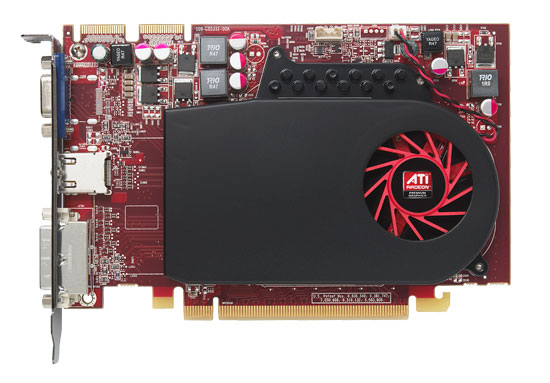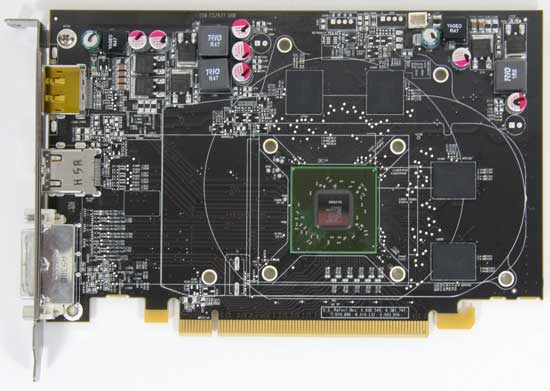AMD's Radeon HD 5670: Sub-$100 DirectX 11 Starts Today
by Ryan Smith on January 14, 2010 12:00 AM EST- Posted in
- GPUs
Meet The 5670
Today’s launch is the Redwood based Radeon HD 5670. The 5670 is a full Redwood card, with all of its functional units enabled and running at its “full” clockspeed. The card we’re looking at is clocked at 775MHz core, and 1GHz(4GHz data rate) on the GDDR5 RAM. With a 128-bit memory bus, this gives the card 64GB/sec of memory bandwidth.

AMD stock photo, our sample boards are black and don't have CF connectors
AMD will be launching the card in a 512MB and 1GB configuration. The $99 card we’re looking at is a 512MB model, while the 1GB model will run $15-$20 more.

Attached to the card are 4 128MB Hynix GDDR5 RAM chips. These chips are specified for a 4GHz data rate, so AMD is only finally pairing up 5000-series cards with appropriately fast RAM. What this means is that unlike the 5700 and 5800 series, there won’t be any freebie memory overclocking to take advantage of the gap between the card’s clocks and what the RAM is specified for. What you see is what you get.
As is common for cards targeted at the sub-$100 price range, the 5670 runs sans external power. AMD puts the TDP for the card at 61W, which compares favorably to the 70W of the GT 240 that we saw last week. AMD tells us that they were merely designing this card to be under 75W, and that the 61W TDP of the shipping product is a good bit lower than they had been planning on.
With the lower power usage of this card, the need for a dual-slot cooler (and the 5000 series distinctive shroud) is gone. The 5670 is equipped with a slightly larger than normal single-slot blower, which blows air towards the front of the card. We call this cooler slightly larger than normal since AMD has extended the heatsink portion slightly to cover all of the GDDR5 RAM chips on the card, as evidenced by the heatsink jutting out of the top. This is an interesting design choice from AMD, since other cards like the 5750 do not apply any cooling to the GDDR5 RAM chips. This does leave us wondering whether cooling the RAM is necessary, or if AMD is doing it for cosmetic reasons.

The card measures at 6.61”, and finally drops AMD’s traditional Eyefinity port configuration. By moving to a single slot, AMD has dropped the 2nd DVI port, leaving the card with a DisplayPort, an HDMI port, and a dual-link DVI port. The card will be able to drive a second DVI monitor using an HDMI-to-DVI adapter, although only a single link. The 5670 still has full Eyefinity capabilities, and a 3rd monitor can be hooked up to the DisplayPort for that task. AMD tells us that the Redwood chip can actually drive 4 monitors, but none of the launch cards will configured for that (not that the 5800 cards were either). AMD’s ideal Eyefintiy configuration for this card is to pair it up with a trio of cheap 16:9 19” monitors, although as we’ll see the card doesn’t really have enough power for gaming like this.
The need for an active DisplayPort adapter is still an issue however, and at $99 the adapters are as much if not more than the card itself. At this point the best solution is a DisplayPort native monitor, but those are still fairly rare and seldom cheap.










73 Comments
View All Comments
Calin - Thursday, January 14, 2010 - link
These lower end series are not intended to run high resolution monitors in "heavy" games at performance modes. For that, there is the 5800 series.These 5600 series seems ok for every game in 19" resolutions and lowered quality, which make them perfect for many people. They are a huge step up from integrated graphics :)
BelardA - Thursday, January 14, 2010 - link
How many people actually buy 19" displays anymore? Wide screen isn't like the older 4:3 screens, so a 19" LCD is kind of small.At $125~150, there isn't much reason to NOT get a 20~21" class monitor.
While the 5600s are a bit on the slow side, there is a NEED to have low-end graphics cards that meets some standards and having an entire product line support DX11 is still a good thing.
Once the price of the 5670 gets down to $75 then it will be a good value card. But not at $100~120 which is the current price on Newegg. And remember, many people don't have the PSUs (or budget) to get support a 5700 series card. I think once 40nm manufacturing matures for TMSC (sp?), the pricing will go down more.
As an owner of a 4670, the 5670 is easily a faster card... but I believe AMD screwed up. The $100 4770 was almost on par with the 4850 and easily faster than the 4830. There is NO reason the smaller die 5670 to be ANY slower than the 4770. That is ALL the 5670 needed to be. But then again, the $135 (today) 5750 is starting to be constantly faster than the 4850 card (good).
SO the real problem is pricing. If the $100 5670 was almost as fast as the $135 5750, there would be no need for the 5750. Also, other than PSU requirements - it would be stupid to spend $120 for a 1GB 5670 when the 5750 is $15 more and almost twice the performance.
Zool - Thursday, January 14, 2010 - link
"They are a huge step up from integrated graphics :)"Price wise the 5670 is a huge step too from integrated graphic. I was mainly comparing the 5xxx and 4xxx series and thats almost a zero jump.
Zool - Thursday, January 14, 2010 - link
But of course why should AMD compete with itself when it still beat everything that nvidia has in price.I think i will skip this generation too and wait for the 6K cards.
Zool - Thursday, January 14, 2010 - link
The 5700 cards are on the same level than 4800 cards and the 5600 cards are very close to 4600 cards. Now if u enable DX11 in games u will se performance way below both 4800 and 4600 for both dx11 cards against they counterpart. Thats downgrading not upgrading.And the X700 vs X800 series trick and price range change is quite disturbing too.
Zool - Thursday, January 14, 2010 - link
How can game developers make better looking games when the performance/price sits on the same level with each generation ? DX11 is very taxing if u want to make it properly. Those fancy new efects, postprocessing with Dx compute just eats much more shader power,bandwith. Performance wise 4800 owners can upgrade only to 5800 cards (dx11 speeds with 5700 is very weak) which price level is another category.But that can happen if your only competition is rebranding a 2006 card architecture because the GT200 was overdesigned. The disturbing part of this is that nvidia cant learn from its mistakes and make another giant chip second time GT300 which is this time even late :).
Zool - Thursday, January 14, 2010 - link
Its quite strange that they downgraded the 5670 TMUs from 32 to 20. With the 60+ GB/s the 32 TMUs could be much more usefull than with the 4670 bandwith. All games use multitexturing to some degree quite some time.Spoelie - Thursday, January 14, 2010 - link
Far Cry 2: the text states that the 5670 and the 4850 have the same amount of memory and that the 5670 beats the 4850.However, looking at the test setup, the 5670 is the 1GB version and the 4850 is the 512MB version, and the test results support this. The gap between the 4850 and the 4870 is *way* too big to not be memory size constraint.
As such, the only reason the 5670 "beats" the 4850 in this test is the memory size, and the supporting text is wrong.
Ryan Smith - Thursday, January 14, 2010 - link
The 5670 is 512MB.The facts have been corrected to fit with reality.
Spoelie - Thursday, January 14, 2010 - link
hmmm ok, then the Far Cry 2 results are a bit peculiar. The 4850 has the same amount of memory but more of everything else and is 25% slower. The performance of the 5670 seems to fall in line with its compute resources, as if it doesn't have a memory bottleneck. This made me think you had a 1GB card. My apologies.